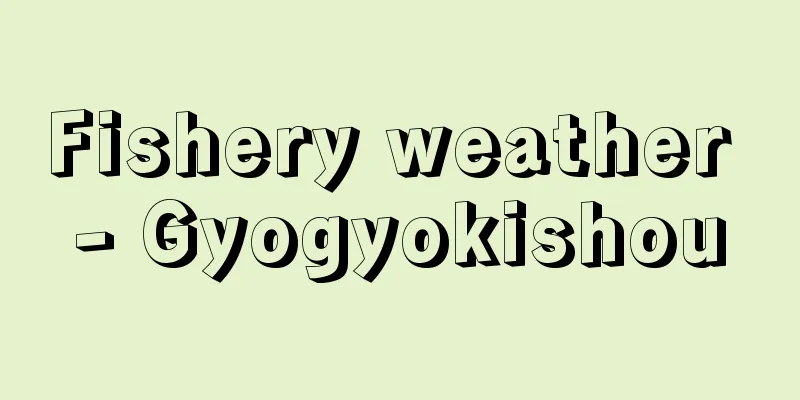Fishery weather - Gyogyokishou

|
This is a field that investigates and studies the relationship between fishing and weather, but also includes weather reports for the safety of fishing boats. It investigates the relationship between the ecology of marine organisms, primarily fish, and the environmental conditions surrounding them, such as water temperature, salinity, density, current, transparency, turbidity, dissolved oxygen, and nutrients. Of these, the main field is sometimes called fisheries meteorology. For example, marine fish have water temperatures that are suitable for their growth, and in places where cold and warm currents intersect in complex ways, such as the waters off the coast of Japan, the distribution of seawater temperatures can tell us the habitats of major fish species. For this reason, the Japan Meteorological Agency reports distribution maps of seawater temperatures to fishing boats. Weather conditions have a significant impact on catches. For example, there is a close relationship between the passage of low pressure systems and the catch of yellowtail, and the catch often increases immediately after the passage of a low pressure system. This is said to be because the passage of low pressure systems stirs up the ocean surface, making it more turbid. As a large-scale phenomenon, the rise and fall of trade winds can promote a rise in seawater temperature off the coast of Peru, causing the El Niño phenomenon, which can deal a major blow to the catch of anchovies. In addition, because the passage of low pressure systems and typhoons can cause accidents at sea for fishing boats, the Japan Meteorological Agency issues fishing weather reports to inform fishing boats of the current weather conditions, high and low pressure systems, and the location and movement of fronts. In addition, the Agency works to prevent accidents at sea by sending radio copies of wave charts for the open ocean and coastal areas, as well as sea ice charts for ships heading out to fish in the North Pacific in winter. [Takao Ando] Source: Shogakukan Encyclopedia Nipponica About Encyclopedia Nipponica Information | Legend |
|
漁業と気象との関係を調査研究する分野であるが、漁船の安全のための気象通報を含める。 水産生物、主として魚類の生態とそれを取り巻く環境条件、水温、塩分、密度、流れ、透明度、濁度、溶存酸素量、栄養塩類などとの関係を調査する。これらのうち主分野をとくに水産気象とよぶことがある。たとえば、海洋の魚類にはその成育に適する水温があり、日本近海のように寒流と暖流とが複雑に交錯する所では、海水温の分布によって、主要な魚類の生息範囲を知ることができる。このため海水温の分布図を気象庁は漁船に通報している。 気象の状態が漁獲量に大きな影響を与える。たとえば低気圧の通過とブリの漁獲量との間には密接な関係があり、低気圧の通過直後からその量が増大することが多い。これは、低気圧の通過による海面の攪拌(かくはん)が濁りを増すためといわれている。また大規模な現象としては、貿易風の消長がペルー沖の海水温の上昇を促し、エルニーニョ現象をおこして、カタクチイワシの漁獲量に大きな打撃を与えることがある。 また低気圧や台風の通過が、漁船の海難を引き起こすので、気象庁では操業中の漁船に気象の実況、高低気圧や前線の位置と動向を知らせる漁業気象通報などを実施している。そのほか外洋や沿岸の波浪図や、冬季間に北洋へ出漁する船舶には海氷図なども無線模写通報によって通報して海難の防止に努めている。 [安藤隆夫] 出典 小学館 日本大百科全書(ニッポニカ)日本大百科全書(ニッポニカ)について 情報 | 凡例 |
<<: Fisheries Cooperative Association - Gyogyokyoudou Kumiai
Recommend
Kami Ezochi
…Although a certain number of Ainu lived in the J...
Feathered bald man
Kabuki dance. Nagauta. Lyrics by Segawa Jokou I, ...
Mir Wais
? ‐1715 Hotaki, chief of the Ghilzai Pashtun tribe...
Storage fee - Storage fee
...In the case of the central aristocracy, the ce...
Shuzo Kuki
Philosopher. Born in Tokyo as the fourth son of R...
Lysimachia vulgaris (English spelling)
… [Ken Inoue]. … *Some of the terminology that me...
Wesendonck Songs - Wesendonck Songs
…Upon learning of this, he fled Dresden and went ...
Liujiaxia - Liujiaxia
This is a large canyon that spans three counties, ...
Red dragonfly - Red dragonfly
It is a general term for species of the Sympetrum...
Battleship - Senkan (English spelling) battleship
A warship with the most powerful guns and robust ...
International Society for Rock Mechanics
…Research into the deformation and fracture of ro...
Teirangana Struggle - Teirangana Struggle
An armed peasant struggle that took place in the T...
Wang Hui - Ouki
A painter from the early Qing Dynasty in China. H...
Vertumnus - Vertumnus
…According to Greek mythology, this was the horn ...
Playgirl - Asobime
…A unique form of epistolary literature was creat...









